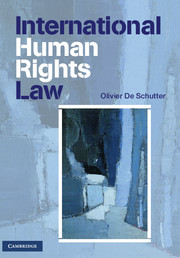Book contents
- Frontmatter
- Contents
- Table of Cases
- Table of Treaties and Conventions
- Table of Comments and Recommendations of Various International Committees
- Introduction
- PART I THE SOURCES
- 1 The emergence of international human rights
- 2 State responsibility and ‘jurisdiction’
- PART II THE SUBSTANTIVE OBLIGATIONS
- PART III THE MECHANISMS OF PROTECTION
- Index
2 - State responsibility and ‘jurisdiction’
from PART I - THE SOURCES
- Frontmatter
- Contents
- Table of Cases
- Table of Treaties and Conventions
- Table of Comments and Recommendations of Various International Committees
- Introduction
- PART I THE SOURCES
- 1 The emergence of international human rights
- 2 State responsibility and ‘jurisdiction’
- PART II THE SUBSTANTIVE OBLIGATIONS
- PART III THE MECHANISMS OF PROTECTION
- Index
Summary
INTRODUCTION
This chapter examines the relevance of the notions of ‘national territory’ and of ‘jurisdiction’ to the determination of situations in which the international responsibility of States may be engaged. This has become one of the most debated issues in international human rights doctrine (see, among many others, the essays collected in F. Coomans and M. Kamminga (eds.), Extraterritorial Application of Human Rights Treaties (Antwerp-Oxford: Intersentia-Hart, 2004); M. J. Dennis, ‘Application of Human Rights Treaties Extraterritorially in Times of Armed Conflict and Military Occupation’, American Journal of International Law, 99 (2005), 119; T. Meron, ‘Extraterritoriality of Human Rights Treaties', American Journal of International Law, 89 (1995), 78; O. De Schutter, ‘Globalization and Jurisdiction: Lessons from the European Convention on Human Rights', Baltic Yearbook of International Law, 6 (2006), 183–245). The main question addressed in much of the literature is whether the notion of ‘jurisdiction’ (taken separately or in combination with that of ‘territory’) designates a condition for a finding of State responsibility which is distinct from that of attribution, or whether instead the two notions – ‘jurisdiction’ and ‘attribution’ – are in fact synonymous and thus interchangeable. And this is indeed the question this chapter focuses upon, although breaking it down into a set of sub-questions corresponding to the different situations in which the question of State responsibility can be raised.
The various human rights treaties differ in their formulations as to the requirements of ‘jurisdiction’ or of ‘territory’, in order to define their scope of application.
- Type
- Chapter
- Information
- International Human Rights LawCases, Materials, Commentary, pp. 123 - 238Publisher: Cambridge University PressPrint publication year: 2010



